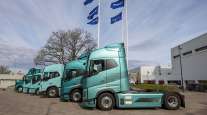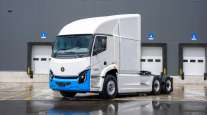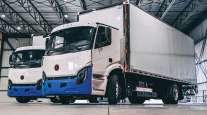Senior Reporter
Suppliers Take Path to Alternative Powertrains

With interest in alternative powertrains heating up, a mix of suppliers and original equipment manufacturers discussed in their latest earnings reports how they are preparing to help customers who face more options than ever.
Transportation power is no longer a one-size-fits-all proposition, according to ACT Research.
ACT sees the development of electric vehicles growing, even while adoption of natural gas engines continues and the efficiency of diesel engines increases, said Kenny Vieth, senior partner at ACT.
Commercial vehicle supplier Meritor Inc., which has 22 prototype programs underway involving 130 electric vehicles, is set to spend about $10 million this year on “both our pure R&D, and also prototype development where we’re not receiving reimbursement from customers,” said CEO Jeffrey Craig.

Craig
“We’ve ramped up the spending a bit from what we had initially expected because of how well the company is performing and the opportunities we’re seeing.”
Meritor’s eCarrier platform integrates an electric motor into the axle, freeing up space for batteries and other components. This flexible design is the foundation for various drivetrain configurations, including full electric, hybrid, and single or tandem axles with various options based on product application for Class 5-8 vehicles.
Independent engine maker Cummins Inc. is preparing to offer powertrain customers a choice: electrified, clean diesel and near-zero emissions natural gas.
Customers “are trying to figure out how to rationalize the many investments they need to make,” said Cummins Chairman and CEO Tom Linebarger. “They’ve got investments to make in autonomous vehicles and electrification, in other technologies, as well as trucks, controls, and then of course more diesel engine and potentially natural gas platforms. So it’s a lot of investment to make.”

Linebarger
Cummins intends to provide whichever platform customers need as well as sub-systems for the truck makers’ own platform, he said. “So we think that proposition is stronger and stronger going forward than it even was in the past.”
Cummins is set to commercialize an electric powertrain in the first quarter of 2020.
“The plan is to invest, to kind of launch, one commercial or two commercial applications, kind of, every year and ramp up adoption,” Linebarger said.
In 2017, Cummins showcased its heavy-duty demonstrator truck that uses a 140 kilowatt-hour battery pack instead of a 12-liter engine.
Meanwhile, using batteries poses several questions: “How do you change them around mid-cycle? How do you reuse them, how do you recycle them?,” Linebarger said. “That’s going to drive a lot of the cost — and therefore the price — of the final units. Again, all that stuff is really in its early days. So I just, I would just say that all of us are kind of trying to figure out at some level.”
One company noted the shift in revenue streams that is coming.
Eaton Corp. projects electrified vehicles will increase to 38% of the global passenger car market by 2030, with share dispersed among battery electric, plug-in hybrid, hybrid electric and mild hybrid electric. Eaton’s inverters can be used in all types of electric vehicles as well as other alternative fuel vehicles, such as hydrogen fuel cell cars and trucks.
Eaton also has more than 15 years of experience in developing commercial vehicle hybrid systems and has a number of vehicle electrification products in the market, including DC/DC converters, power distribution units, battery-electric transmissions, and high-voltage fuses. (DC to DC converters are electronic circuits that convert a source of direct current (DC) from one voltage level to another)
“As the world moves to electrification and the eMobility segment, that also becomes revenue that comes out of our legacy vehicle business and shows up in eMobility. And so there are a number of factors that are going on that perhaps make the underlying revenue growth and our vehicle business look worse than it really is,” Eaton Chairman and CEO Craig Arnold said.
For Paccar Inc., the next 12-24 months are “very critical for us to sort of define our way forward,” said CEO Ron Armstrong. “We will be sort of figuring out what the best path is for us for the longterm. There is still quite a bit of a challenge with respect to the economic viability of some of these powertrain choices and can they survive without high degree of subsidization.”
Paccar is developing its own products and working closely with a variety of suppliers who are developing their capabilities, he added.
At the same time, Paccar recently opened an office in Silicon Valley where it is developing its autonomous trucks. “We have multiple paths that we’re working on there,” he said.




